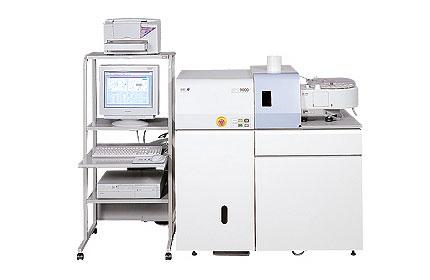|
Instrument Database:
SII Nano Technology Inc. - SPQ9000se ICP Mass Spectrometer
| |
|

|
| |
|
| |
|
| Year of introduction |
|
| Status |
available |
| Company |
SII Nano Technology Inc.
|
| Categories |
Mass spectrometer: ICP-MS
|
SPQ9000se series is a mass spectrometer using ICP as ionization source. Q-deflector acquires high reputation for its maintainability. This device is designed for highly sensitive measurement of ultra trace elements contained in samples from semiconductor production process. High sensitive and stable measurement of ultra trace elements has been enabled by utilizing sample introducing system dedicated for the purpose.
Features SPQ9000 Series Highlights
- SPQ9000 Series features an all-in one structure with built-in radio frequency generator and vacuum pump, and larger options such as the auto sampler can be placed inside the device, allowing it a minimized installation space. Functions necessary to optimize the device, ion lens voltage, torch location, mass axis calibration, resolution and applied voltage of the detector, can all be adjusted automatically. Also, using the 90 degrees deflector lens (Q-Deflector) enables analysis of high matrix samples such as organic solvents.
- Q-Deflector: Previous versions of ICP-MS were vulnerable against matrix. Major reasons were salt deposits inside the cone and lens contamination. In particular, the ion lens and the mass spectrometer are located inside the vacuum so their maintenance had been a hassle. The Q-Deflector is a breakthrough system that solved the problem of ion lens contamination. Ion, light and neutral components that are pulled from the plasma into the vacuum enter the Q-Deflector formed by four electrodes through the ion lens. The Q-Deflector bends the ion's path 90 degrees and the ion moves to the mass spectrometer. Other components pass through the Q-deflector and are removed from the vacuum chamber. With this process, the ion lens is not contaminated by high matrix samples and can maintain a clean condition, preventing diminution in sensitivity and destabilization in measurements caused by contamination.
- Chamber Gas Induction System: One of the problems with ICP-MS had been the interference of molecular ions. In particular, argon-based molecular ions, such as ArO and ArH that forms plasma, forms a high background, deteriorating the minimum detection limit of the affected element. As a result, it was difficult to analyze low concentration of elements such as potassium, calcium and iron that are affected by argon-based molecular ions. By inducting the argon gas from the spray chamber into the plasma, the chamber gas converts it into plasma that is less likely to produce argon-based molecular ions (cold plasma). As a result, it is possible to analyze low concentrations by improving the minimum detection limit of elements such as potassium, calcium and iron.
- This is a system designed for high sensitivity/semiconductor related analysis. It is designed to achieve high sensitivity compared to previous SPQ9000. In particular, the minimum limit of detection in measurements in cold plasma conditions has improved twofold. Therefore, it is the system best suited for low concentration analysis of high-purity samples, and is able to conduct high-sensitivity analysis of multiple elements of ppq-ppt order. Furthermore, by using in combination with the optional AT400 Microscopic HF Automatic Analysis System, automatic analysis of microscopic amount of hydrofluoric acid samples (e.g. wafer recovery fluid) is made possible
|
Related links:
|